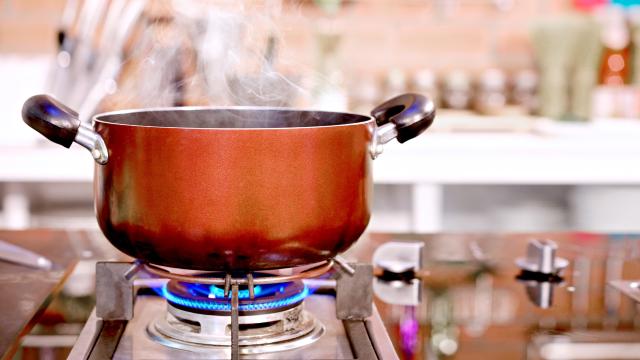An oil inferno is pretty much the worst-case scenario in any kitchen, but do you know how to respond if a grease fire happens to you? Here’s what to use to safely and quickly put out a blaze on your stovetop.
Do not use water
One of the most important things to remember is to never pour water onto a grease fire. It may be counterintuitive, but water can make a grease fire worse. As the saying goes, water and oil don’t mix, and dumping water onto burning grease can lead to splashes that only spread the fire further. If you’ve ever splashed water into a pan of hot oil and suffered a burn from oil going everywhere, imagine that scenario, but with the splashes of oil are also on fire.
Instead, start with these steps to put out a grease fire:
- Turn off the source of heat.
- Try to remove oxygen from the flame by covering with another pot or a baking pan.
- If you can’t cover it, smother the fire with a generous amount of baking soda or salt until it’s extinguished.
- If the fire is too big for smother, baking soda, or salt, use a fire extinguisher.
- If you suspect the fire is larger than you can handle, call 000.
Smother the fire
If the fire is small enough, a simple smothering will be enough to allow you to move on with your cooking. Use a pot lid, a wet cloth, or a fire blanket if you happen to have one, covering the base of the fire until it’s starved of the oxygen it needs to live. This is the first (and easiest) option you should take for minor fires that can be extinguished quickly.
Use baking soda or salt
Small fires can also be extinguished with baking soda or salt — two common ingredients you will likely have handy. Neither is a perfect solution, as both require either a large amount or a minor fire, but both are practical options given their availability in an average kitchen.
The most important caveat to using these common household items is that you need to be sure what you are grabbing, as similar-looking powders — flour, baking powder, sugar, biscuit mix, and so on — are combustible and will make the fire worse. Be careful that the white powder you grab in a panic is one that will actually help you.
Use a proper fire extinguisher
If you have a larger kitchen fire and smothering or tossing some baking soda and salt onto it isn’t enough, you need to step up your efforts with a proper fire extinguisher. For larger grease fires, an amateur cook and Navy veteran answering a question on Stack Exchange suggests having a specific type nearby — a Halon extinguisher or Aqueous Film Forming Foam. Both are fire suppressants used on Navy vessels that can handle more than just your small Thanksgiving Day grease fire. It’s probably overkill for your average kitchen fire, but useful for larger kitchens or heavy-duty cooks who want to be prepared.
Similar to using water, though, using a fire extinguisher improperly can dampen your efforts to deal with the problem. As you can imagine, shooting a pan full of grease with a pressurised substance can knock things over and cause the fire to spread. Follow the instructions written on the extinguisher, which will include standing back and using the extinguisher until the fire is completely gone, which may take a little longer than you’d expect. Many extinguishers are single-use only, so be sure to familiarise yourself with the type of extinguisher you have and, if needed, replace it after using.
This story was originally published in 2013 and updated on November 25, 2020 with more complete and accurate information.

Leave a Reply
You must be logged in to post a comment.